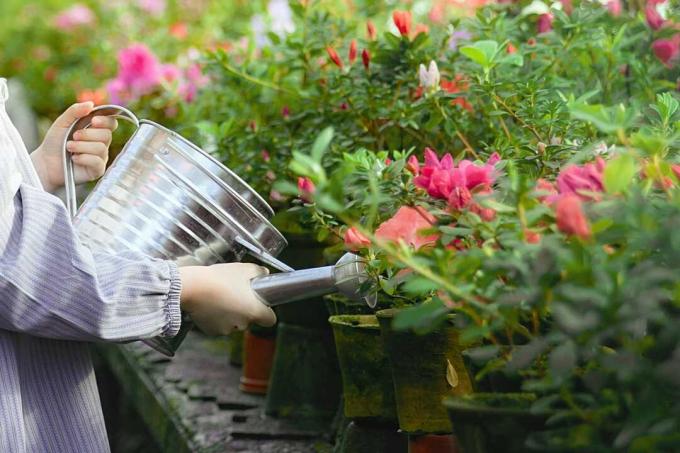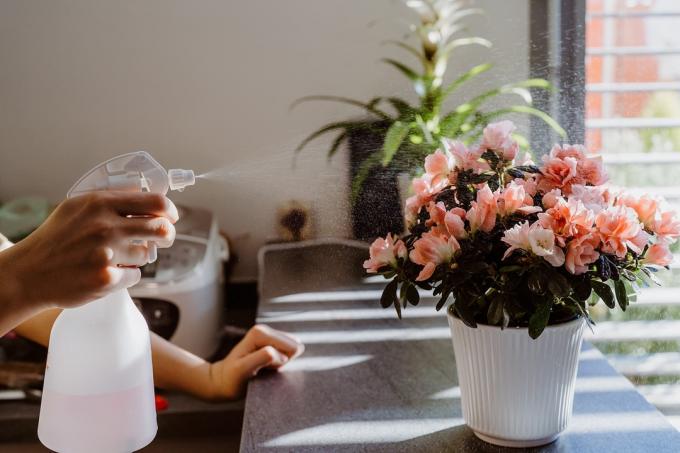
Azaleas inspire with colorful flowers, but their demands are not without. The sensitive plants react quickly with leaf discoloration or leaf loss. This is what you should do when your azalea turns brown leaves.
In a nutshell
- Find the cause and take countermeasures
- Lack of water: water immediately with plenty of water; Immersion bath for indoor azaleas
- Iron deficiency: lower the pH value of the soil, spray with iron fertilizer, water with little lime
- Leaf spot disease: cut off and discard affected parts
- Temperatures that are too high: avoid blazing sun and dry heating air
Table of contents
- First step: examine the azalea
- Cause 1: lack of water
- Cause 2: leaf spot disease
- Cause 3: Iron deficiency
- Cause 4: Wrong location
- frequently asked Questions
First step: examine the azalea

gets one garden azalea brown leaves in autumn and gradually throws them off, that is correct. Namely, garden azaleas are different from their relatives
Rhododendrons, just deciduous. indoor azaleas (Rhododendron simsii), on the other hand, remain leafy all year round. But even with them, a few brown leaves every now and then are normal. Because leaves have a limited lifespan, age, turn brown and fall off. Instead, new green grows. In all other cases, there is no delay in investigating the cause, because an azalea with many brown leaves quickly becomes unsightly and can even die.Cause 1: lack of water

If the leaves are not only brown, but also partially dried up, the azalea is very likely not getting enough water. You can also recognize a lack of water by the fact that the soil of the brown-colored azalea is dry. Don't just look at the surface of the earth, however, or you may come to the wrong conclusion. The surface of the soil can and will dry out between two waterings, especially in summer. It is best to stick your index finger 2-3 cm deep into the ground. If you don't feel moisture at this depth, you are indeed dealing with dehydration.
A notice: Persistent waterlogging can also lead to water shortages in the long term. It lets the roots of the azalea rot in secret, so that at some point the plant can no longer absorb enough water.
What to do?
Water your brown azalea immediately. However, avoid getting the foliage wet in a hurry. A dip is recommended for potted azaleas:
- Fill buckets with rainwater
- alternatively use decalcified tap water
- Put the azalea in the bucket (only the pot can be under water)
- leave in the water bath until no more bubbles appear
- Remove and drain the azalea
Cause 2: leaf spot disease

Source: Razbak, Rhododendron ponticum Cercospora handelii, pontic rododendron Cercospora handelii (3), Edited from Plantopedia, CC BY-SA 3.0
"Leaf spot" is a collective term for various bacteria, fungi, and viruses that cause mottled brown leaves on azaleas. As a rule, you cannot determine at home which pathogen has infested your plant. This is also not necessary to combat leaf spot disease. It is only important that you recognize these signs of illness and interpret them correctly:
- brown to black leaf spots
- yellow spots also possible
- rounded or elongated discolorations
What to do?
Act on just a few stains. Otherwise, leaf spot disease spreads very quickly. The more leaves and shoots are affected, the less chance there is of saving the beauty of the azalea. Neighboring plants can also be infected. How to proceed correctly:
- Cut off affected parts of the azalea completely
- use sharp scissors
- Disinfect cutting tools before and after cutting
- Dispose of clippings as household waste, do not compost
Tip: Fertilize your garden azalea after cutting back due to disease nettle brew. It provides many nutrients and thus helps to strengthen the weakened plant.
Cause 3: Iron deficiency

The rhododendron family, which includes the azalea, loves acidic soil. This is rarely found in the garden, and normal potting soil is not acidic at all. If you don't create an acidic environment for your azalea, you will damage it in the long run. If the pH value is too high, it interferes with the absorption of nutrients. If there is also calcareous irrigation water, there is an iron deficiency (chlorosis) preprogrammed. The leaf edges of the azalea will first turn yellow before gradually turning completely brown.
What to do?
The absorption of iron has to get going, the newly absorbed element has to develop its effect. You can do this:
- Spray azalea foliage with iron fertilizer
- Lower the pH of the soil
- with rhododendron earth, needle litter
- Repot houseplants in acidic soil
- water immediately with rainwater or decalcified water
Tip: The ideal pH value for azaleas is between 4 and 5.5. If you want to know for sure if your azalea's soil is acidic enough, you should measure the pH level. This is easy and inexpensive with test strips from the garden center.
Cause 4: Wrong location

If the azalea is too sunny or too warm, this can also result in brown leaves. Especially in the winter months, the indoor azalea likes it a little cooler. The room temperature should not exceed 20 degrees Celsius. Direct sunlight or insufficient humidity in the living room also affect the plant.
What to do?
If the location is not correct, you can react to this with various measures:
- Plant in a shadier, cooler place
- Avoid direct sunlight at all costs
- bought copies slowly get used to the climatic conditions in the house
- first set it a little “colder” (e.g. B. in stairwell or conservatory)
- a little warmer after a few days (east or west windows ideal)
- for sufficient high humidity care for
- Set up water bowls or spray plants with soft water from time to time
A notice: Avoid being near the heating, especially in winter. The warm, dry air quickly dries up azaleas.
frequently asked Questions
Leaves marked with leaf spot disease must be removed and discarded immediately. Brown leaves caused by lack of water or iron may remain on the plant until they fall off on their own. You can remove them earlier for aesthetic reasons.
Water and nutrient deficiencies can be the cause of brown flowers. Pest infestation and blossom rot are also possible causes.
Azalea soil should always be moist but not too wet. To keep them in this condition, indoor azaleas are watered about once a week. With garden azaleas, the watering frequency must be based on the weather. Under no circumstances should azalea roots be permanently wet!



